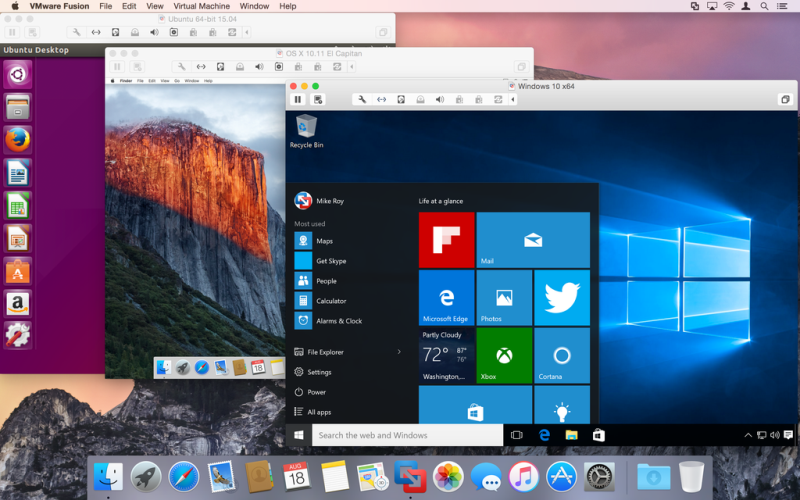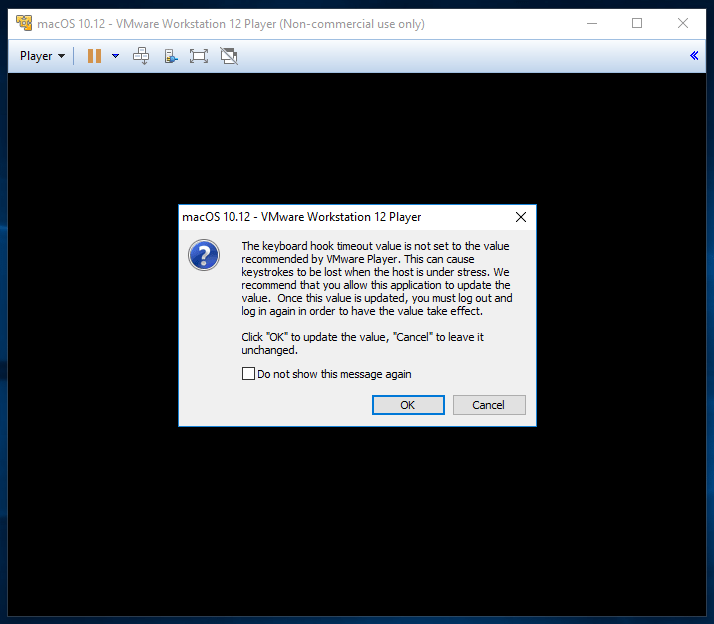Virtual Machine For Windows 10 To Run Mac Os X
Windows 10 Pro, Education and Enterprise editions come with a built-in hypervisor client Hyper-V allowing users to create and run other operating systems on a virtual machine. Although Hyper-V is mainly designed to run Windows guests it can also be used to virtually install other operating systems like various Linux versions. Don't buy a Windows license, don't reboot and don't use a Virtual Machine. Try a free trial of CrossOver to run your Windows software on Mac, Linux and Chrome OS.
- Virtual Machine For Windows 10 To Run Mac Os X
- Virtual Machine For Windows 10 To Run Mac Os X On Windows
- Virtual Machine For Windows 10 To Run Mac Os X 10
- Virtual Machine For Windows 10 To Run Mac Os Xenon
The Microsoft Java Virtual Machine (MSJVM) is a discontinued proprietary Java virtual machine from Microsoft. It was first made available for Internet Explorer 3 so that users could run Java applets when browsing on the World Wide Web. It was the fastest Windows-based implementation of a Java virtual machine for the first two years after its release.[1]Sun Microsystems, the creator of Java, sued Microsoft in October 1997 for incompletely implementing the Java 1.1 standard.[2] It was also named in the United States v. Microsoft Corp. antitrust civil actions, as an implementation of Microsoft's 'Embrace, extend and extinguish' strategy. In 2001, Microsoft settled the lawsuit with Sun and discontinued its Java implementation.
History[edit]
Performance[edit]
The Microsoft JVM won the PC Magazine Editor's Choice Awards in 1997 and 1998 for best Java support. In 1998 a new release included the Java Native Interface which supplemented Microsoft's proprietary Raw Native Interface (RNI) and J/Direct. Microsoft claimed to have the fastest Java implementation for Windows, although IBM also made that claim in 1999 and beat the Microsoft and Sun virtual machines in the JavaWorld Volano test.[1]
Antitrust trial[edit]
Microsoft's proprietary extensions to Java were used as evidence in the United States v. Microsoft Corp. antitrust civil actions.
A Memorandum of the United States in Support of Motion for Preliminary Injunction in the case of United States of America vs. Microsoft claimed that Microsoft wanted to kill Java in the marketplace.
In short, Microsoft feared and sought to impede the development of network effects that cross-platform technology like Netscape Navigator and Java might enjoy and use to challenge Microsoft's monopoly. Mac os x install yarn. Another internal Microsoft document indicates that the plan was not simply to blunt Java/browser cross-platform momentum, but to destroy the cross-platform threat entirely, with the 'Strategic Objective' described as to 'Kill cross-platform Java by grow[ing] the polluted Java market.'[3]
Sun vs. Microsoft[edit]
In October 1997, Sun Microsystems, the creator of Java, sued Microsoft for incompletely implementing the Java 1.1 standard.[2]
In January 2001, Sun and Microsoft settled the suit. Microsoft paid Sun $20 million and the two agreed to a plan for Microsoft to phase out products that included the older version of Microsoft Java that allegedly infringed on Sun's Java copyrights and trademarks.
- Office XP Developer
- Office 2000 Developer
- Office 2000 Premium Service Release 1
- Microsoft BackOffice Server 2000
- Internet Security and Acceleration Server (ISA) 2000
- Visual Studio 6 Microsoft Developer Edition
- Windows 98 and Windows ME
The Microsoft Java Virtual Machine was discontinued in 2003 in response to the Sun Microsystems lawsuit. Microsoft continued to offer support until December 31, 2007.[4]
Windows XP[edit]
The initial release of Windows XP in 2001 did not ship with a Java virtual machine, because of the settlement with Sun. The settlement required people who wanted to run Java Applets in Internet Explorer to download and install either the standard Sun Java virtual machine, or to download a copy of the Microsoft Java virtual machine.
Service Pack 1 (SP1) for Windows XP was released on September 9, 2002. It contained post-RTM security fixes and hot-fixes, compatibility updates, optional .NET Framework support, and enabled technologies for new devices such as Tablet PCs. It also included the Microsoft Java virtual machine.[5] On February 3, 2003, Microsoft re-released Service Pack 1 (SP1) as Service Pack 1a (SP1a). This release removed Microsoft's Java virtual machine in compliance with the lawsuit with Sun Microsystems.[6]
See also[edit]
References[edit]
- ^ abNeffenger, John (August 1, 1998). 'Which Java VM scales best?'. JavaWorld. Retrieved 2020-07-16.
Microsoft SDK 2.02 still stands alone as the only fast and scalable Java virtual machine. Our customers with the highest Web site traffic currently have no other viable choice for a JVM.
- ^ abZukowski, John (October 1, 1997). 'What does Sun's lawsuit against Microsoft mean for Java developers?'. JavaWorld. Retrieved 2020-07-16.
- ^Memorandum of the United States in Support of Motion for Preliminary Injunction UNITED STATES OF AMERICA v. MICROSOFT CORPORATION, May 18, 1998
- ^'Archived copy'. Archived from the original on 2014-08-31. Retrieved 2014-08-19.CS1 maint: archived copy as title (link)
- ^'Windows XP Service Pack 1 preview'. September 9, 2002. Archived from the original on 2010-07-02. Retrieved 2007-09-21.
- ^'Differences Between Windows XP SP1 and Windows XP SP1a'. February 3, 2003. Retrieved 2007-09-21.
External links[edit]
- Microsoft Java Virtual Machine Support at the Wayback Machine (archived January 8, 2014)
- Microsoft Java transition FAQ at the Wayback Machine (archive index)
- Award-Winning Virtual Machine Continues to Provide Fastest, Most Integrated Java Language Support at the Wayback Machine (archived November 11, 2012). Microsoft Press release, Dec. 7, 1998
- Darryl K. Taft - Microsoft to Junk Flagship Products, Cites Java Settlement. December 5, 2003. eWeek
- Joe Wilcox and Stephen Shankland - Microsoft's Java decision a mixed bag. CNET, March 18, 2002
Ever found yourself in a situation where you loved software, only to know that it is compatible with Mac machines? Agreed, it is an anomaly as the number of Windows compatible software is vast. But at times, you might find yourself in such a situation or may come across with certain apps that work better on macOS.
If you are stuck in such a situation, here we will state ways for you to run Mac apps on Windows 10 device. Surprised! Don’t be, just remember nothing is impossible.
Ways to run Mac Apps on Windows 10
Step 1: Make a Virtual Machine with macOS on it
This is the simplest way to get Mac on Windows and run Mac apps on windows PC. To learn how to run Mac programs on Windows check out my tutorial on How to Install macOS Mojave on Windows 10 in a Virtual Machine?
The step by step guide will make you learn how to get macOS virtual machine and how to install it on Windows 10.
Once you have the virtual machine up and running with macOS on it, come back here to learn ways to install and run Mac apps on Windows.
Step 2: Use your Apple Account
From this step onwards everything will work in a similar manner as it works on actual macOS. You’ll need to login into your Apple account to access App Store. If you don’t have one you’ll need to create an Apple account.
To create an Apple account on a web browser, follow the steps below:
1. Head to Apple ID account page, fill in all the particulars given in the form to create your AppleID. Remember provided email address will be your new AppleID.
2. Next select security questions, if you want to receive updated checkbox to subscribe.
3. Click Continue.
These simple steps will help you create an Apple ID.
Once done login to your Apple account to start downloading apps from App Store. To access App Store click on App Store icon present in the dock. Log in to your Apple account > look for the app you wish to download > click on Get > Install.
This will install the apps on your macOS virtual machine installed on Windows 10.
Using these simple steps you can use macOS on Windows 10 with the help of a virtual machine.
This might hit you with questions like what about the current session? Will you able to resume it from where you left or not?
To resume working from where you left you would need to shut down virtual machine in a sequence for this click on Apple logo > Shut Down. This will help you resume working.
However, if you want to extra cautious you can take a snapshot, to save the current state of the virtual machine.
To take a snapshot on VMware click on VM > Snapshot > Take Snapshot.
Next, give a name to the snapshot and hit Take Snapshot.
This way you’ll be able to save your current session.
Using these simple steps you can easily run Mac Apps on Windows machine. However, you must never forget since you are using a Virtual machine they might not work as on actual macOS. This is simply due to a virtual machine sharing the host machine’s system resource. In addition to this, a piece of advice avoid updating your macOS Virtual Machine as the patch that makes the macOS virtual machine run is compatible with a specific version and may not work with the updates.
FAQ’s
Can you run Mac apps on Windows?
You can run Mac apps on Windows 10 easily, but before that you need to install macOS on Windows 10 in a virtual machine. Here, virtual machines play an important role to imitate dedicated hardware by emulation of a computer system. You also need to download and install certain essential tools such as VMware to run Mac apps on Windows 10.
Can you run Mac on a PC?
Yes you can run Mac on a PC like a pro. To do this, you would require a compatible PC where you can install macOS. Here, you need to select the hard drive on which you never had Windows installed. You can run Mac on a PC by creating an image file of macOS or doing it through a virtual machine.
Can you download Apple apps on Windows 10?
Apple’s iTunes apps are now available to download on Microsoft’s Windows 10 Store. It is useful development for users who wish to access iTunes apps on Windows 10. Here, you can download, purchase, and manage iTunes apps easily from Windows 10 Store.

Is it safe to use Hackintosh?
Well, it totally depends on the method you use to access macOS on Windows machine. If you create an image of macOS and clone it on Windows PC or you try a virtual machine to access Mac apps on windows PC, you probably are in safe hands. On the other hand, it could be debatable whether using Mac on Windows is legal or not, as you are licensed to use the software and license terms don’t allow you to imitate software.
Is a Hackintosh worth it?
If you want to access all features and functionalities of Mac without spending money on buying new Mac system, then Hackintosh is a good option. It is also useful for users who tend to work on two different systems that require access to Mac and Windows features.
Virtual Machine For Windows 10 To Run Mac Os X

Virtual Machine For Windows 10 To Run Mac Os X On Windows
Of course, you can give it try, but keep in mind you can lose everything on the virtual machine in this process.
Virtual Machine For Windows 10 To Run Mac Os X 10
Hurry up….! Subscribe to our YouTube channel to stay updated with tech related information.
Virtual Machine For Windows 10 To Run Mac Os Xenon
Recommended Readings:
